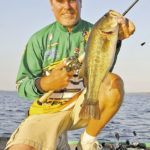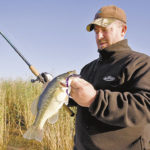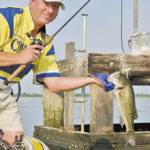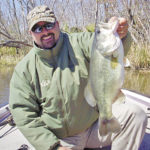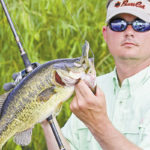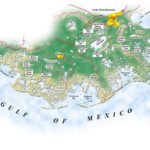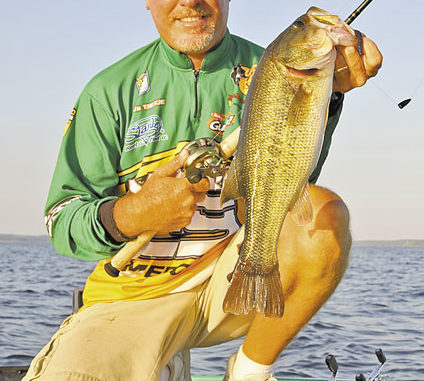
On the fertile, immense Louisiana Delta, picking the right spot will determine the 2011 Bassmasters Classic winner.
The last two Bassmaster Classics that were held in New Orleans opened some eyes as to just how good we have it here in South Louisiana. This one will open the rest of them. February is a far cry from the syrupy and stagnant Louisiana summers in that just about all the bass in the marshes surrounding New Orleans will be either gearing up for the spawn or actually spawning rather than seeking relief in the shade.
Prominent fishing patterns might not be much different because, let’s face it, bass trying to survive in the marsh don’t have time to think about whether what they see in front of them is a shrimp, shad or a spinnerbait.
In other words, this Bassmaster Classic won’t be nearly as much about what contestants are casting as it will where they are casting. To think that this tournament will come down to who can better punch a jig, who can better burn a blade or who can better flip a worm is nothing more than a perverted pipe dream.
This Bassmasters Classic will come down to which contestant can find that one magical spot that can give up three consecutive 15- to 20-pound five-bass limits.
Putting all eggs in one basket is risky because of all the variables of the Louisiana Delta, but the contestant that finds the spot that can weather a north wind, tame the tide and withstand the Mississippi River wildcard will win.
After all, the Louisiana Delta isn’t a perfectly manicured man-made reservoir with neat little boat houses all lined up in a row; it is a labyrinth that confines largemouth bass more suited for receiving human sacrifices than the paparazzi treatment.
Make a wrong turn at the wrong time, and you’ll be eaten alive. Make the right turn at the right time, and you’ll get to ride around the floor of the New Orleans Arena with the Classic trophy in one arm and an American flag in the other.
Venice bass will be in dead-ends
Venice was not so secretly one of the hottest bass-fishing destinations in all of Louisiana last summer and fall. As crazy as it may sound, anglers were catching more than 100 bass a day with lots of 3- and 4-pound fish.
Many veteran bass anglers believe that as long as the Mississippi River doesn’t flood and the wind doesn’t blow hard out of the north, Venice will offer that three-day consistency that the Classic competitors are looking for.
Capt. Cade Thomas is more known for putting his customers on the speckled trout and redfish bite down the river, but actually he and his dad Donnie Ray got started chasing bass at Venice.
And when he gets the time, Thomas trades in his popping corks and leadhead jigs for plastic worms and spinnerbaits to get in on some of the best bass fishing Louisiana has to offer.
“Bass are getting ready to spawn down here during February,” he said. “That means the main pattern will pretty much be fishing in dead-end canals. The Wagon Wheel and Delta Duck will have a lot of fish. Venice Marina and Cypress Cove will hold fish in February. And there are some dead-end canals up around Fort Jackson that are also pretty good in February.”
Depending on the conditions, Thomas says bass could be at the beginning stage of the spawn when they gang up at the mouths of the dead-end canals all the way to the actual spawning phase when they will spread out on the flats in the far backs of the canals.
“I like to get as far back in the canals as I can get unless the tide is falling,” Thomas said. “If the tide is falling, it’s good to start on the outside of the dead ends and pick the corners and work your way in as long as there’s enough water to get in.”
Thomas says the three main baits to use in Venice during February are spinnerbaits, black/blue 3/8-ounce jigs and Texas-rigged red shad plastic worms with 1/4-ounce weights. The spinnerbaits work well at the points and around any grass in the canals, and the jigs and worms are for pitching to the cane and other isolated pieces of cover.
“One of the keys this time of year is to look for dead-ends that run due north or east to west,” Thomas explained. “If I’m around 15 or 20 dead-end canals and I didn’t have time to fish them all, I’d definitely stick with these. The ones to the north don’t get all the cold wind and the water doesn’t fall out as quick, and the ones that run east to west get more sunlight.”
Thomas concluded by pointing out that he believed if somebody were to go to Venice and the conditions were right, he could expect anywhere from 20 to 25 pounds a day that would probably be made up of four 3- to 4-pound fish with maybe a 6- to 7-pound kicker in the bag.
Grass holds key to Caernarvon bite
There’s going to be a big stringer of bass caught if somebody goes to Delacroix, but local bass tournament angler Jason Pittman doesn’t know if a big sack could be duplicated three days in a row.
“I would expect somebody to go to Caernarvon maybe on the last day of the tournament if they’re trying to swing for the fence,” said Pittman. “The only problem is that might not be the right day based on the conditions. There are fish to be caught. I don’t think it will produce the numbers of big stringers, but it may produce the consistent smaller stringers.”
Perhaps the only problem with Caernarvon will be getting there. In fact, if a competitor decides to head to Caernarvon by way of running down toward Venice and crossing over at Ostrica to run back up the Pencil Canal, Pittman says he better be on top of the bite because he’s looking at having only two or three hours to fish.
“Somebody could lock into the river at Harvey or the Industrial Canal and then lock back out of the river at the Intracoastal Canal, but that would be two sets of locks to negotiate,” Pittman continued. “If you don’t hit it right, you could lose your entire day.”
Because of the February full moon being around the 18th, Pittman believes this Classic is setting up to be a spawn tournament. At Caernarvon, that means bass will be in the canals or around the points of the canals. He pointed to the dead-end canals off the major lakes like Lake Lery and the Crow’s Foot as being two potential hotspots.
The thing to realize about Caernarvon is that it hasn’t been getting the respect it had before Hurricanes Katrina, Ike and Gustav. The absence of the grass had as much to do with the tough fishing as anything else.
“The grass is coming back, though,” Pittman said. “The diversion has been on all year with the oil spill, and all that fresh sediment has come with the fresh water, so the grass has come back. This grass could open up some things for somebody willing to weigh the risk of running to Caernarvon with the reward.”
Since he expects the grass to come into play, Pittman says two of the better search baits should be spinnerbaits and Rat-L-Traps. As for whacking the fish once they are found, most locals rely on junebug or watermelon-red Zoom Speed Craws punched through the mats.
“The main thing they’ll have to watch over here is the north wind,” Pittman said. “That wind will blow the water out and make the boat running and the fishing tricky. Think about it. If the bass were on the bank in 2 feet of water, and the north wind blows, everything’s gone, and it’s game over.”
During this time of year, Pittman says 12 to 15 pounds is realistic, 15 to 18 pounds would be a good day and 18 to 20 pounds would be knocking it out of the park.
Anglers hoping for winter like 2009 at Cataouatche
Because of its proximity to the Classic launch site at Bayou Segnette State Park and its reputation for giving up 10-pound bass this time of year, it’s going to be difficult for some tournament competitors to pass up Lake Cataouatche.
However, things aren’t always as they appear.
“It changes every year since they cut the water on,” said local bass tournament angler Lucas Ragusa. “The grass does different things. A couple years ago, the whole lake grassed up. Last year they beat it back with chemicals. How good Cataouatche is in February will depend on how much the grass grows.”
Davis Pond pumped most of 2010 because of the oil spill, and a lot of grass has actually started growing in Lake Salvador. The entire area is freshening up more and more every year, so the likelihood of there being grass and bass only in Cataouatche is slim.
“If it stays mild through January and early February, some grass will stick around,” Ragusa added. “If the diversion is pumping out cold water from the river, it will kill it out pretty quick along with the ducks and coots. If all this good grass dies out, then it’s a matter of how much grows back by the Classic. Who knows where the grass or the bass will actually be.”
As long as this remains a mild winter, Ragusa says anglers may find the exact conditions that created the bass smash of two years ago. Back then there was a mild January and February, and the warm water and grass combination in the shallow northern part of Cataouatche and the Tank Ponds produced ideal conditions.
Cataouatche is really nothing more than a giant spawning flat with a hard bottom and lots of shell. Not only does that attract lots of bass, it attracts lots of bass anglers. Therefore, if the weather is warm and stable leading up to the Classic, Ragusa says local pressure could come into play.
“If it’s on during that off-limits period, you can bet Cataouatche is going to get hammered by the locals,” said Ragusa. “It would be better for the Classic guys if it’s cold during that off-limits period and warming going into the tournament.”
One key to Cataouatche, according to Ragusa, is moving water. Regardless of whether it’s tidal movement or water moving through Davis Pond, bass simply bite better when the water is moving.
“My experience is when the pumps don’t run or the tide doesn’t move, the fish don’t bite,” Ragusa said. “It will disgust you too because everything looks so right — tons of bait, good-looking cover, but no bites.
“And when that muddy water from the diversion mixes with that gin-clear marsh water, it’s either the clearest dirty water you’ve ever seen or the dirtiest clear water you’ve ever seen. Either way, you can see a spinnerbait rolling 2 feet under the water.”
Ragusa expects spinnerbaits and soft plastics to rule the day at Cataouatche during the Classic with maybe a chatter bait coming into play. Some favorites are Brush Hogs, Speed Craws and trick worms fished around the grass.
Consistent weather needed for Bayou Black
There’s a reason most of the local bass tournament circuits kick off their seasons at Bayou Black during January and February. If the fish haven’t already spawned by the end of January, at least they’re getting ready to spawn. This early activity and fast warming water means anglers can more easily put fish in the box.
Corey Wheat, who along with tournament partner David Cavell were Anglers of the Year for the South Louisiana Media Team Trail, has fished Bayou Black enough to find lots of spawning bass as early as late January.
“It’s my experience that the bigger bass spawn earlier in the year down there,” said Wheat. “Certain parts of the marsh warm up quicker depending on the weather, and the big ones will go ahead and move onto the beds. The only problem with that, though, is that a cold front can really impact the fish a lot more than other areas.”
The parts of Bayou Black that Wheat believes Classic competitors will find most productive are the dead-end canals with scattered coontail and hydrilla. Some may even have a few scattered lily pads. Places like Orange Grove, 70-mile Canal, Bayou Penchant and Bayou Copasaw should get the lion’s share of attention.
“Those areas are not too far reaching coming out of Segnette,” Wheat said. “It’s over an hour drive time, but you’ll still have more time to fish than if you go south to Venice. And you can make that run without having to refuel.”
If anglers find that the bass are right in the middle of the spawn, Wheat says they’ll probably be blind casting to spawning fish because it’s usually not clear enough for actual sight fishing. Rather, anglers target isolated pieces of cover where they imagine a bed might be, or they look for the territorial swirls of bass protecting their nests.
Baby Brush Hogs, lizards, jigs and tubes will all be popular choices if bass are on the beds, and spinnerbaits will come to the forefront if bass are still in the prespawn stage. Wheat says spinnerbaits work especially well fished around visible cover and the secondary grass lines under cloudy conditions as long as the fish aren’t tucked away right up against the banks.
“And these fish in Bayou Black mix together size wise,” Wheat added. “In certain areas, you can catch a lot of bass, but you’re going to go through some small ones to catch the big ones. It’s either that or do something dramatically different with your baits or presentation.”
Wheat said that a 15- to 20-pound bag of fish would be doable out of Bayou Black, but the possibility of repeating such a feat three days in a row would be difficult. To repeat this kind of weight each day of the event, anglers are going to need three or four good days of weather all lined up in a row.
“You can catch a big sack down there one day, but the weather changes before you can get back the next day, and everything’s changed,” Wheat said. “These bass will shut down and become lethargic. They don’t necessarily leave, but they get hard to catch.”
